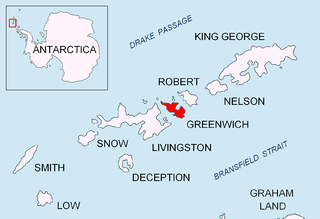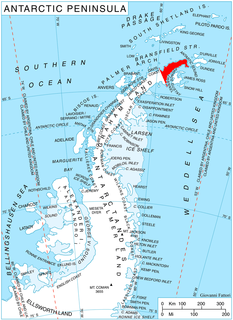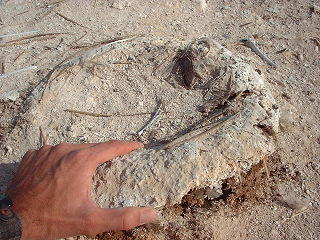
The Dailey Islands are a group of small volcanic islands lying off the coast of Victoria Land, 9 kilometres (5 nmi) northeast of Cape Chocolate, in the northern part of the ice shelf bordering McMurdo Sound. They were discovered by the British National Antarctic Expedition, 1901–04, under Robert Falcon Scott, and named for Fred E. Dailey, the expedition carpenter.

The Windmill Islands are an Antarctic group of rocky islands and rocks about 11.1 kilometres (6 nmi) wide, paralleling the coast of Wilkes Land for 31.5 kilometres (17 nmi) immediately north of Vanderford Glacier along the east side of Vincennes Bay. Kirkby Shoal is a small shoal area with depths of less than 18 metres (59 ft) extending about 140 metres (459 ft) westwards and SSW, about 3.4 kilometres (2.1 mi) from the summit of Shirley Island, Windmill Islands, and 0.24 kilometres (0.15 mi) NW of Stonehocker Point, Clark Peninsula.

The Ibar Rocks are two rocks located 0.4 kilometres (0.2 nmi) east of Bonert Rock and 1 kilometre (0.6 nmi) southeast of Canto Point, Greenwich Island, in the South Shetland Islands. The names "Islote Ibar" and "Islote Teniente Ibar" appearing on Chilean hydrographic charts in the 1950s refer to the larger and western rock. The recommended name "Ibar Rocks" includes a submerged outlier to the northeast of the larger rock. Teniente (lieutenant) Mario Ibar P. signed the official act of inauguration of the Chilean Captain Arturo Prat Base on Greenwich Island in 1947.

Alectoria Island is a low, nearly ice-free island less than 2 kilometres (1 nmi) long. It lies in Prince Gustav Channel, about 1 kilometre (0.5 nmi) off the terminus of Aitkenhead Glacier, Trinity Peninsula, Antarctica. It was surveyed in 1945 by the Falkland Islands Dependencies Survey, who named it after the lichen Alectoria which was predominant on the island at the time.

Beak Island is an arc-shaped island, 7 kilometres (4 nmi) long and 360 metres (1,200 ft) high, lying 1 kilometre (0.5 nmi) northeast of Eagle Island in the northeast part of Prince Gustav Channel. It was probably first seen in 1902–03 by members of the Swedish Antarctic Expedition under Otto Nordenskiöld. The Falkland Islands Dependencies Survey surveyed Beak Island in 1945 and so named it because of its shape and relative position to nearby Tail Island and Eagle Island.

Borradaile Island is one of the Balleny Islands. It was the site of the first landing south of the Antarctic Circle, and features the "remarkable pinnacle" called Beale Pinnacle, near Cape Beale on its south-eastern coast, and Cape Scoresby on its north-western coast.

Breton Island is a small rocky island lying 0.4 kilometres (0.2 nmi) southwest of Empereur Island. It was charted in 1950 by the French Antarctic Expedition and named by them for their largely Breton crew.

The Buffon Islands are a group of three adjoining, rocky islands, together about 0.5 kilometres (0.25 nmi) in extent, lying 0.2 kilometres (0.1 nmi) east of Petrel Island in the Geologie Archipelago. They were charted in 1951 by the French Antarctic Expedition and named by them for Georges Buffon, a noted French naturalist.

Descartes Island is a rocky island 0.2 kilometres (0.1 nmi) long, midway between Lagrange Island and La Conchee and 1.7 kilometres (0.9 nmi) north-northeast of Cape Mousse. It was charted in 1951 by the French Antarctic Expedition and named after René Descartes, the French mathematician and philosopher.

Piton Island is a small rocky island lying 0.19 kilometres (0.1 nmi) southwest of Guano Island in the Curzon Islands. Charted in 1951 by the French Antarctic Expedition and so named by them for its very pointed shape.

Mendori Island is the northernmost in a group of three small islands which lie 1 kilometre (0.5 nmi) northwest of the strait separating Ongul Island and East Ongul Island, Antarctica. It was mapped from surveys and air photos by the Japanese Antarctic Research Expedition (JARE), 1957–62, and was named "Mendori-jima" by JARE Headquarters in 1972 in association with Ondori Island, which lies 0.4 kilometres; 0.2 miles (0.2 nmi) northward.

Manchot Island is a rocky island lying in the entrance to Port Martin, Antarctica. It is 0.4 kilometres (0.2 nmi) west of Bizeux Rock and 0.4 kilometres (0.2 nmi) north of Cape Margerie. The island was photographed from the air by U.S. Navy Operation Highjump, 1946–47, and was charted by the French Antarctic Expedition, 1949–51. It was so named by the French expedition because a large Adélie penguin rookery was located on the island, and "manchot" is a French word for penguin.

Marguerite Island is a rocky island 1.3 kilometres (0.7 nmi) northwest of Empereur Island and 3.2 kilometres (1.75 nmi) north-northwest of Cape Margerie, Antarctica. It was charted in 1951 by the French Antarctic Expedition and named by them for Marguerite, a character in Goethe's Faust.

Lagrange Island is a small rocky island 0.7 kilometres (0.4 nmi) northeast of Newton Island and 3 kilometres (1.5 nmi) north of Cape Mousse, Adélie Coast, Antarctica. It was charted in 1951 by the French Antarctic Expedition and named after Joseph-Louis Lagrange, the French mathematician.

Laplace Island is a small rocky island 0.6 kilometres (0.3 nmi) west-northwest of La Conchée and 1.4 kilometres (0.75 nmi) north of Cape Mousse, Antarctica. It was charted in 1951 by the French Antarctic Expedition and named by them for Pierre-Simon Laplace, the French astronomer and mathematician.

Larrouy Island is an island 9 kilometres (5 nmi) long and 4 kilometres (2 nmi) wide which rises to 745 metres (2,440 ft), lying in Grandidier Channel off the northwest coast of Velingrad Peninsula 7 kilometres (4 nmi) north of Ferin Head, Antarctica. It was discovered by the French Antarctic Expedition, 1903–05, under Jean-Baptiste Charcot, who named it for Paul Augustin Jean Larrouy, at that time a French Minister Plenipotentiary.

Leopard Island is an island 0.4 kilometres (0.2 nmi) long, lying 0.4 kilometres (0.2 nmi) west of the southwest end of Skua Island in the Argentine Islands, Wilhelm Archipelago, Antarctica. It was charted and named in 1935 by the British Graham Land Expedition under John Rymill.

Bluff Island is an island lying 1 kilometre (0.5 nmi) south of Magnetic Island and 4 kilometres (2 nmi) west of the Breidnes Peninsula, Vestfold Hills, in Prydz Bay, Antarctica. It was mapped from aerial photos taken by the Lars Christensen Expedition, 1936–37, re-emapped by the Australian National Antarctic Research Expeditions (1957–58) and so named because the south end of the island is marked by a steep cliff face.

Newton Island is a rocky island 0.9 kilometres (0.5 nmi) northwest of Laplace Island and 2 kilometres (1.2 nmi) north-northwest of Cape Mousse, Adélie Coast, Antarctica. It was charted in 1951 by the French Antarctic Expedition and named after Sir Isaac Newton, English philosopher and mathematician.










